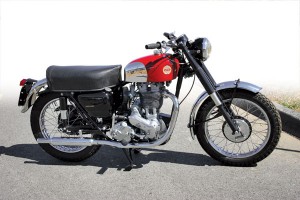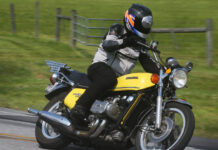story and photography by Clement Salvadori
[This Retrospective: Ariel Red Hunter 500cc: 1932 – 1959 was originally published in the February 2011 issue of Rider magazine]
Ask most Americans about Ariel motorcycles, and chances are you will get a blank look. Those who remember the name, effectively defunct since 1965, will probably think of the Square Four, a 1,000cc four-cylinder model that had some popularity in the United States in the ’50s. But the real backbone of the company was the Red Hunter 500, and this 1955 HS model was the sportiest of the lot. The Hunter Scrambler was intended for competition, and in the best British clubman tradition was meant to be ridden to the event, lights removed, raced and then ridden home.
The Red Hunter name dates back to the Great Depression, and two of the great names in British motorcycle development are responsible. The first was Val Page, a brilliant engineer working for Ariel who developed a beefy 500 single back in 1926. It was so reliable that in 1929 two Brits put an Ariel with that engine between two 18-foot pontoons, rigged a drive to a propeller and rode across the English Channel to France. Good publicity.
Then a fellow named Edward Turner came to work at Ariel and designed the first Square Four, which appeared at the annual Olympia Show in late 1930. Soon he was in charge of developing new product, and elected to put a tuned version of Page’s 500 single in a model called the Red Hunter, which appeared late in 1932. Turner understood that styling sold, and these were nicely prepared, with lots of nickel-plate sparkle and a glossy red paint, the sort of bike the sporting Englishman might hope to own. It was a success, and with that success Ariel bought the Triumph company, and Edward Turner went to work there, and become famous. While Val Page moved on to the BSA company.
In those years the Red Hunter line, epitomizing powerful singles, also included 250s and 350s, and all had rigid frames and girder forks. Following World War II the 250 was dropped, with the 350 NH and 500 VH carrying on the Hunter name. It should be noted that in 1948 a 500cc vertical twin, the KH, acquired the Red Hunter sobriquet, but twins were never considered in the same league as the singles. In the best British tradition, these postwar iron-engined thumpers had big flywheels and a relatively relaxed camshaft, along with a low 6:1 compression ratio, since the octane rating of the still-rationed pump gasoline was close to 70.
The primary drive used a single-row chain, with a spring-type shock absorber built into the crankshaft sprocket to reduce abruptness and consequent stretch on the chain, always a concern. A dry clutch passed power through a four-speed Burman gearbox. The frame was prewar in style, with a single tube coming down from the steering head, connecting with two tubes that cradled the engine. In 1946 the girders were swapped out for telescoping forks.
Development continued and before long a sprung frame, with plunger suspension, was available as an option, much appreciated by the commuter types who had to ride to work every day over roads that had not seen much fixing since 1939. As was a QD (Quickly Detachable) rear wheel—always important in those days of tender innertubes. A new sidestand was standard, instead of just that clumsy rear-wheel stand. And this modernizing was followed by a rush to the brand-new American market, as the pound was devalued by 30 percent at the Bretton Woods economic confabulation in 1949—British motorcycles had suddenly become cheap in the colonies!
The R&D department was building an all-alloy engine, which appeared in the summer of 1949 in competition-only versions of the Hunter, labeled the VHA. On 72 octane fuel the VHA turned out 26 horsepower at 6,000 rpm; not bad.
Its most visible aspect was that the pushrods, previously outside in two chromed tubes, were now incorporated in tunnels inside the cylinder. In a couple of years the alloy engine was used on the street versions as well, and a speed of 90 mph was possible. One tester wrote that the performance was a bit beyond “gentlemanly,” a great compliment.
In 1954 a swingarm rear suspension was available, with a new duplex frame and even a centerstand. In effect the 500 Red Hunter model came in two variations, street and competition, with the street version, reverting to cast-iron barrels, called the VH, the alloy competition coming in either the HS (Scrambles) or HT (Trials) versions, with designated marking found on the timing cover. Having a good sporting reputation was important to Ariel, and the HS scrambler came with bumpier cams, stronger valve springs, higher compression and a straight-through exhaust. Every engine was bench-tested at the factory and had to put out 34 horses at 6,000 rpm.
Ariel came out with two HS models, the Mark I and Mark III—there was a Mark II with a new-fangled front suspension, but only half a dozen were ever built. The Mark I (the one in the photos) was a bike intended for racing, with a 9:1 compression ratio and a rather peaky motor. The Mark III was a more benign machine, with an engine that developed usable power at much lower revs, and had lower compression, 8.2:1. They both came stock with QD lights, a generator and battery, horn and speedometer. As well as a downswept exhaust system with proper muffler. This Mark I was a motorbike that earned respect from the owners of BSA Gold Stars (developed by Val Page) and Norton Internationals, two of Britain’s more sporting half-liter singles.
These big singles were of an admittedly elderly design, and the Red Hunter’s life span was drawing to a close. Ariel asked 300 dealers what sort of motorcycles they would like to see in the coming years, and they said they wanted a lightweight two-stroke twin. R&D went to work.
In preparation for the new model the HS and HT units disappeared after 1958, and the VH in 1959, along with all the remaining Ariel four-strokes. In 1960 Ariel went two-stroke, with the 250cc fully enclosed Leader and naked Arrow…jocular types would say the Hunter was killed by the Arrow. The 250s were good machines, but ended up doing poorly against the Japanese two-strokes that descended on the motorcycle world in the early ’60s.
We should not forget to mention that in 1959 Turner, who had promoted the Red Hunter 27 years before, introduced the immensely successful Triumph Bonneville.








you missed the electron crankase model available in scramble form with rigid frame.god knows why.and for extra with lights dyno 21 inch front wheel guards in road form. from 1948 to 1951. these were built in a limited no and raced with some success by people such as stamps hicks in the us.these motors were built in such small numbers(i believe 230 odd) that the vch engine numbers were used on them,and were mostly inserted into a vch frame although the motors were not vch. a very confusing and obscure model found in various forms.i have a photo of one on its delevery day in 1951 from prats of geelong with a panel top tank with speedo,this doesnt happen according to nearly all ariel info you pick up but most of us know during assembly they sometimes put on what they had if there was a shortage.thats enough waffling for now. ps i have the bike in the photo.